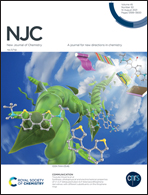An electrochemical method for the sensitive and rapid sensing of Sudan I in food based on Ni–Fe bimetal organic frameworks†
Abstract
Traditional metal–organic frameworks (MOFs), although have the ability to accumulate some chemicals from solution, are usually electrochemically inert. Here, spherical MIL-53(NiFe) MOFs have been synthesized via a simple solvothermal method. A series of characterization methods including scanning electron microscopy (SEM), transmission electron microscopy (TEM), X-ray diffraction (XRD), Fourier transform infrared (FT-IR) spectrophotometry, energy dispersive X-ray spectroscopy (EDS), and element mapping were used to investigate this material. An MIL-53(NiFe)/AB/GCE-modified electrode was constructed using acetylene black (AB) as the conductive substrate, which can make up for the electrochemical inertness of metal in the MOFs to some extent. Moreover, the bimetallic center can coordinate with the azo functional group in Sudan I to some extent, which is beneficial to the binding of the molecules to the electrode. Thus, the sensitive and rapid detection of Sudan I can be realized. The quantitative determination of Sudan I was carried out via the differential pulse voltammetry (DPV) method in a wider linear range (0.005–10 μM) and lower detection limit (0.002 μM, S/N = 3). The developed method can be successfully applied to the detection of Sudan I in chilli powder and tomato paste with satisfactory results.



 Please wait while we load your content...
Please wait while we load your content...